
History FrauenFreiluftGalerie
At a glance:
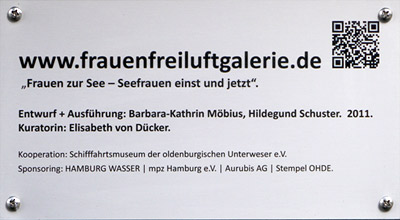
Inscription sign
- has been in existence since 1994 has a long-term project. Altogether (as of April 2015) 15 murals at architecturally interesting buildings / walls. This is the only open air gallery in Germany by artists with a focus on working women. more
- tells about the changing role of working women in the port of Hamburg from 1900 to the present day.
- creatively designed by women artists from Hamburg and overseas, using various styles and with aesthetic positions.
- researched and curated by cultural and social scientists. more
- extends along the north bank of the river Elbe over a distance of roughly 2 km from the fish market to Oevelgönne. more
- follows on from Hamburg’s first women’s mural: "100 Years Working Women in the Port" by the Museum of Work and the Women’s Working Party in the Museum of Work. It was created to mark the occasion of the 800th port anniversary in 1989 (initially the mural was 1,000 sm in size, extended to 1,300 sm); demolished in 1994. The current project leaders were also involved in the preceding project. more
- based among others on the philosophy of the Mexican muralist movement "muralismo", whose paintings, the murales, were seen as public art during the Mexican revolution from 1910.
- funded by public and private money and own commitment. more
- eine for a picture gallery of the history, click here
Function of the gallery:
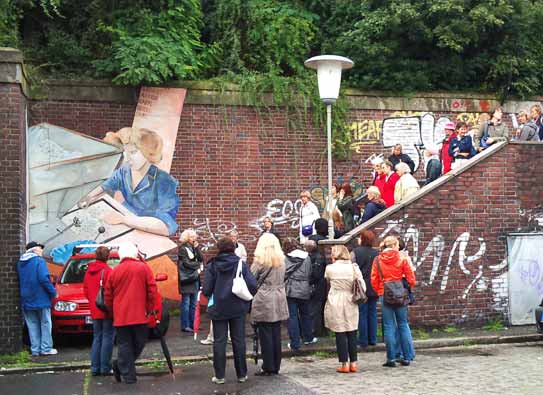
During a tour, 2011
Photo: Isabell Chowaniec
- Eye opener: it triggers conversations about the still persisting myth that the port is a men’s world with all the stereotypes, and an increasingly different port reality today where working women are gradually growing in number / becoming a more common feature.
- It reveals overlooked stories of working in the port in combination with current perspectives of women employed in the port today. more
- It acts as a special memento in a transforming landscape, embedded in a profound transformation process from what used to be industrial port and dockland labour, to the leisure and services sector today.
- Guided tours can be booked (German / English). more
- Information: inscription signs at the individual murals together with the QR code, flyers, website: http://www.frauenfreiluftgalerie.de/en/ and sources: http://www.frauenfreiluftgalerie.de/quellenverzeichnis.php
Outlook:
A new, updated mural is being prepared for the late summer 2015 that features "WOMEN working in the fish industry in the past and present". The mural had vanished without replacement during the modernisation work to the Hummer Pedersen building in 2014. The project welcomes ideas, material that can be used for the mural, and donations.
Sharing requests:
+++ finding new locations +++ restoring the murals +++ sponsoring and support of all kinds +++ national/international sharing among the female artists +++
Project leaders:
Dr. Elisabeth von Dücker, art and culture historian, curator of the gallery,
and Hildegund Schuster, artist, muralist.
More information:
The Women's Open Air Gallery Hamburg has been in existence since 1994 as a long-term project that is unique here in Germany. Murals along the northern bank of the river Elbe in Altona tell stories about women working in the port from 1900 to the present day: an open air gallery with murals at buildings and walls with an interesting industrial history. Artists from Hamburg and overseas have designed the murals in different styles, with social and culture historians researching the various topics.
The gallery reveals a kaleidoscope of jobs and life styles, particularly when the conventional definition of work in the port and docks is amended by adding jobs that have become indispensable for the port to keep going. Work in the port and docks is usually defined by jobs involved directly with handling, transporting and storing goods - activities that used to exclude women and still frequently do so today. Our attention therefore focuses on the women working in and for the port. This change of perspective has revealed many women working in the port, also in the preceding project from 1989 described below.
Some examples of what has been revealed:
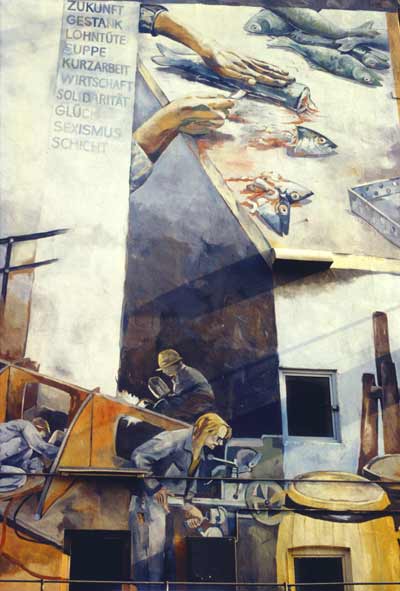
Detail of the mural dated 1989:
woman filleting fish, woman welder,
woman metal worker
Photo: Hildegund Schuster
- Women have always worked in the fish industry. From 1960 onwards, they came as migrant workers from Portugal or Turkey.
- Port companies employ women as cleaners or office workers.
- Self-employed sex workers have always earned their living as street prostitutes in the port.
- Looking back to the 19th century, we see coffee bean sorters doing seasonal work in the port. It was their walk-out in 1896 that triggered the major strike of dock and shipyard workers in Hamburg: indeed, they can be said to have written a hitherto unknown chapter in the city’s history.
- The story of the female forced labourers belongs to the darker, suppressed sides of Hamburg’s port history: during the war years, female Jewish concentration camp prisoners were forced to clear rubble in the port from 1942 onwards. One mural recalls these women with the example of Cecilie Landau, now Eichengreen by marriage. The Jewish girl from Eimsbüttel was the only member of her family to survive the holocaust and the years of forced labour.
- Or later during the 1950s when it was still common practise to rule women out of jobs in the port and docks, new prospects opened up for working women in West Germany: the acute shortage of men meant that some jobs on ships were opened to women. For example, from 1954 onwards women worked as radio operators on West German ships. However, it was not until 1987 that women could qualify for the ship master’s certificate.
- Or: it is only since 2006 that women have been allowed to take jobs as qualified port logistics workers. Since then, they operate cranes for loading and unloading containers at HHLA (Hamburg’s port and logistics operator). Up to that point in time, these were men’s jobs in a men’s world.
Chain of pearls
The Women’s Open Air Gallery Hamburg forms a unique kind of cultural "chain of pearls". Since the end of the 20th century, the working and living worlds along the northern bank of the river Elbe have gone through a fundamental transformation process. And here in amidst the new buildings for services, offices and tourism constructed since the 1990s, we find a series of visual thought-provoking memorials which trace the disappearing or no longer visible face of the female port workers, in juxtaposition with present-day perspectives of the women who work in the port here and now.
Insights into the changing role of female economic power and corresponding reflections are compacted into collages, acting as an intervention and making people talk - a special memento in a transformation landscape.
By the way, the idea of a chain of pearls on the bank of the Elbe goes back to Hamburg’s former Chief Planning director Egbert Kossak and his restructuring ideas. His Construction Forum of 1985 triggered the revitalisation of the northern bank of the river Elbe which had become wasteland by the early 1980s. Architects from all over the world came together in the Construction Forum to develop ideas and utopias for the marginal parts of the port,(1) now clearly and unmistakably on display for today’s visitors to the area. Recently the river bank has become lined with a plethora of new-builds such as "Kristall" and "Columbia Twin Tower", which according to their investors are "first-rate architectural highlights". Most of the new buildings are used for offices, something which is viewed with increasing criticism in a city that currently has approximately 1.4 million square metres of vacant office space.(2)
The women’s mural of 1989
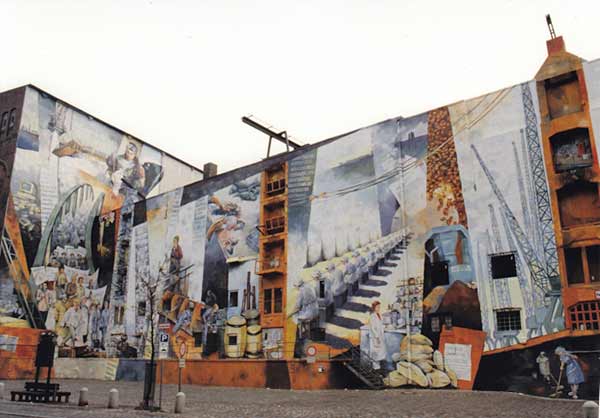
Mural of 1989
Photo: Britt Stranzen
The predecessor of the Women’s Open Air Gallery was Hamburg’s first women’s mural entitled "100 Years Working Women in the Port" which initially covered 1,000 sm of wall space. It was demolished in 1994. The first mural was produced in 1989 for the "Women’s Working Party in the Museum of Work"(3) on the northern facade of what was called the fish market warehouse, a former grain silo in Große Elbstraße 39.
The reason for creating the mural was to be part of the celebrations planned for 1989 to mark the 800th port anniversary. To this end, the working party wanted to create a mural that would reveal what had remain concealed up to that point in time, namely the mostly ignored work and jobs done by women in the port, which was usually see as a "men’s world".
A painted collage on a wall right in the heart of the port intended to draw public attention to scenes of women working in the port with pictures of the other half of the port world (4)
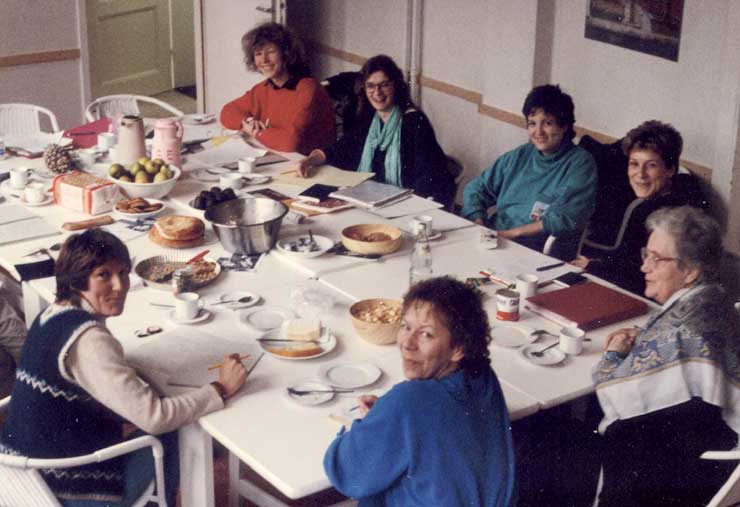
Working session of the Women’s Working Party in the
Museum of Work.
The following women were involved in the mural project of 1989: Maria Beimel, Christiane Chodinski, Hilde David, Sarah Deutelmoser, Elisabeth von Dücker, Miryam Freitag,
Ulrike Gay, Inge Henker, Wiebke Hohrenk, Sabine von Kessel, Elena Luksch, Gudrun Kipp, Claudia Krull, Elke Mätschke, Gisela Milse, Emilija Mitrovic, Gabriele Schärer, Gesa Schneider, Hildegund Schuster, Britt Strantzen, Johanna Tiedemann, Gisela Utesch
Photo: Hilde David
With this major project in mind, three years previously in 1987 the Women’s Working Party in the Museum of Work had grown in number to more than twenty women aged between 25 and 77 years, including historians, pensioners, students, housewives, social scientists, office workers and media workers such as graphic designers, filmmakers and painters. A kind of interdisciplinary women’s history workshop cooperated with the Museum of Work that was currently being founded at that time. The workshop activities included exploring and research, artistic work and wrestling for an attractive site for the mural in the fish market.
The group defined its work as a women’s research cultural policy project. The aim on the one hand was to illuminate and process the concealed corners of city history: in the mid 1980s, scarcely any research was being done into the role played by female economic power in the port. On the other hand, the plans to convert the research findings into a mural were a novelty in their own right.
Embedded in the virulent ideas of the time that advocated a firm feminist foothold in the public domain, the mural project saw itself as an experiment in open air presentation or portrayal of pictures that tell the story of women’s everyday lives and gender issues in the city. The whole concept also reflected the ideas of artist Josef Beuys, who sees research and art not just as a scientific and aesthetic process but as a social one as well.
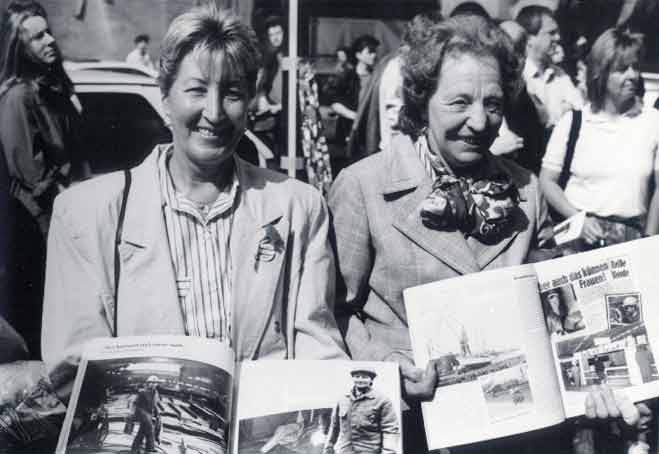
The welders Elvira Vierke (left) and Inge Lüde
at the First Brush Stroke Celebration
with their interview in the catalogue book
Photo: Britt Strantzen
This was made particularly clear by the fact that the research was pursued not just in the archives but also as oral history research directly in the workplaces. Altogether more than 100 interviews were conducted with contemporary witnesses who earned their money in the port in yesteryear and in the present day - witnesses whose "invisible" and indispensable work in the family or household ensured that the port keeps going.
Hildegund Schuster, an artist from Hamburg, became part of the project group already during the early research phase. She was joined later on by two other artists Wiebke Hohrenk and Gisela Milse to paint the mural in early 1989.
The artists completed the 1,000 sm of mural in just three months. They began work after the official First Brush Stroke Celebration organised on 1 May 1989 by the Women’s Working Party in the Museum of Work with a great many contemporary witnesses and supporters. The event was a well-attended kick-off for the painting work; at the same time, it also gave a special touch to the May Day celebrations. This was followed in the summer with the "de-scaffolding" event on 29 July 1989 to celebrate the free view of the finished mural.
The women’s research cultural policy project was an experiment and a novelty on a nationwide scale. It certainly got people talking in Hamburg and way beyond, with opinions ranging from approval through to objections along the lines of "feminist realism".
The women’s mural of 1992
Three years after completing the mural, the Women’s Working Party in the Museum of Work, which was now a smaller group, once again turned its attention to producing a mural in what was being celebrated as the Columbus Year 1992.

Mural of 1992 (right)
Photo: Hildegund Schuster
Commemoration celebrations were once again the starting point, this time referring to 500 years since the discovery and colonisation of Latin America. This gave rise to a critical review: the idea was to expand the mural of 1989 by adding 300 sm on the west side of the warehouse to achieve a total size of approx. 1,300 sm, this time with a focus on "the other side of the coin".
In other words, the aim was to reveal those kinds of job that enhance prosperity in western countries as illustrated by Hamburg, while remaining unseen and scarcely known, mainly done by women - and usually for a pittance, to the benefit of the employers.
For the new mural, the women’s working party of the museum cooperated with the project "Compañera 92. Coproduction Women Latin America – Hamburg", a women’s culture project that wanted to offer a different view and cultural approach to the Columbus celebrations, seeing it as a "Conquista Year" of colonization. The intention of the "Compañeras" was to create a network between the various activities of women here in Hamburg and those in Latin America.
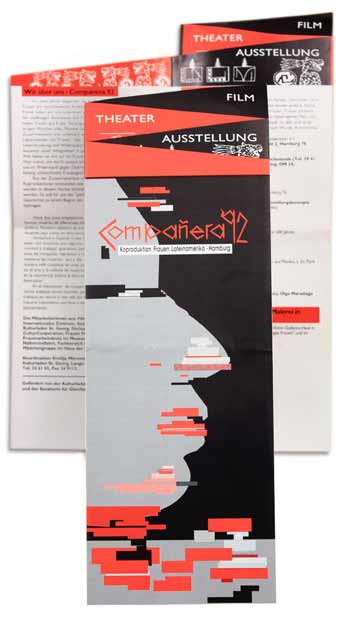
Flyer about Compañera 92
In the summer of 1992, artistic activities delved into questions of women’s everyday lives here and in Latin America and asked how colonialism influenced these lives in patriarchal societies, looking particularly at issues of racism and gender discrimination.(5)
Supported with public funds, this cultural co-production resulted in Hamburg in films, exhibitions and murals, among others, including our mural. This was also a lesson for the active members of the women’s working party along the lines of "decolonising the mind-set".
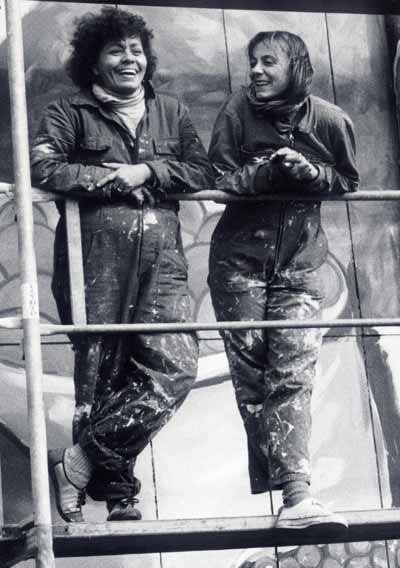
The artists Olga Maradiaga Zuniga (left),
Hildegund Schuster, 1992
Photo: Karin Plessing
For the women’s mural project, this meant in particular not just talking about working women in Latin America and Latinas in general, but also pursuing a joint project with a Latin American artist.
The women’s working party invited the painter Olga Maradiaga Zuniga from Leon, Nicaragua, to join the project. Work then began with the Hamburg muralist Hildegund Schuster and the women’s working party from the museum.
The working party chose three jobs as examples: the banana washer, the coffee bean picker and the migrated sex worker.(6) In terms of composition, the artist used the highly complex motif to link the original and the extended mural, with fluttering bank notes symbolising the transfer of goods and money along the lines of money makes the world go round. They designed the mural measuring roughly 300 sm directly on the west water side of the fish market warehouse.
Bright colours and a backdrop of exotic vegetation revealed the pictures of "typical" women’s jobs to the public view. Clearly visible from afar and even from shipping on the river, they also acted as a welcoming gesture at the entrance to Europe’s key import port for bananas and coffee, as well as pointing a finger at the high demand for women to provide sex services.
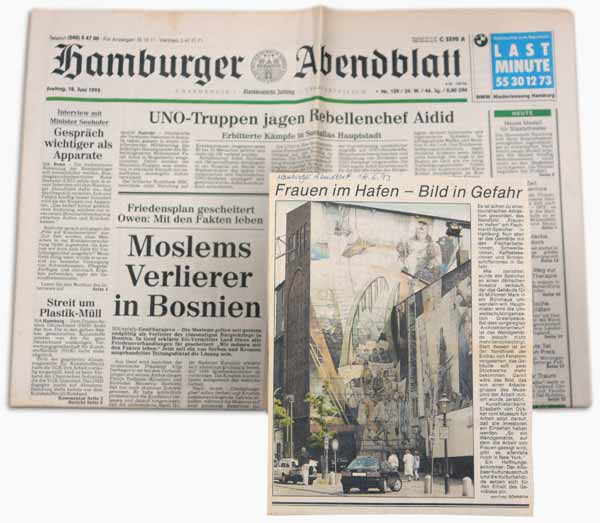
Inauguration on 1 November 1992.
This international painting which had also become an interesting feature for curious passengers on port boat trips was not destined to have a long life: just two years later, the whole mural was lost when the warehouse was converted into an office building.
Women’s Open Air Gallery Hamburg since 1994

Demolishing and concealing the mural on the
north facade of the fish market warehouse, 1994
Photo: Hildegund Schuster
But before the year came to an end, continuation was in sight: three women from the former museum working party: the painter Hildegund Schuster, the museum scientist Dr. Elisabeth von Dücker and the social scientist Emilija Mitrovic, then developed a follow-up concept for the "Women’s Open Air Gallery Hamburg"..(7)
The intention was to continue the "forensic" artistic/historical research into women working in the port, using the area that the large mural had already defined as a women’s culture site. However, this time the aim was to produce a succession of collages rather than one solitary picture.
The Große Elbstraße which runs roughly 2 km along the river bank from the fish market out to the west was ideal for the project as it is a centuries old key access road for port, trade and industry with all the corresponding buildings. Stories of how people work and live can be found along this road like a cultural chain of pearls running parallel to the river.
Work then began in 1994, after the investor involved in the fish market warehouse made amends for the unfortunate demolition with a small amount that made a certain financial contribution. In time, it transpired that obtaining wall surfaces would be the more complicated task.
Muralismo
Both the original and the current mural project are inspired by the philosophy of the Mexican muralist movement, "muralismo". These wall paintings, the murales, provided a public, artistic view of the social and political conditions prevailing during the Mexican revolution.
They acted as the central communication medium for political enlightenment since 1910. At the same time, the murals were in democratic ownership, as explained in 1929 by José Orozco, who was one of the Muralismo pioneers in those days together with Diego Rivera and David Siqueiros: "Murals are the highest, strongest and most consistent form of painting. They are also the least selfish because they cannot be used for personal benefit. They are for everyone".
This is also how we see our gallery, although we tend to avoid the confessional timbre that prevailed back then in Mexico. The open air murals on the bank of the river Elbe can be viewed 24/7 for free as public art. They trigger conversations about the still persisting myth that the port is a men’s world, with all the associated gender stereotypes, in an increasingly different port reality today where working women are gradually growing in number and thus also become a more common feature.
No other city offers an opportunity to wander through an open air gallery with murals that have something different to tell from the tall stories often found in seamen’s yarns(8) while taking a look at the other side of port-related jobs where a gradual transformation is taking place in the gender-specifics of jobs that always used to be done by men.
Geld - Money - Dinero
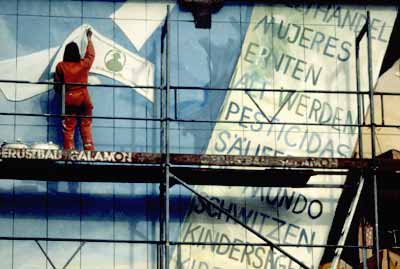
Wandbild 1992, Hildegund Schuster on the scaffold
Photo: Leslie Franke
The Women’s Open Air Gallery Hamburg is funded by public and private donations and own commitment.
It is supported among others by Hamburg Department of Culture, Altona District Assembly, the fish market warehouse investor R&S, Altona Art Foundation and private donations. New additions are always welcome.
After all, if the gallery is going to be on display in the long term, on-going maintenance and restoration costs must be expected.
Murals need walls
Actually, the Women’s Open Air Gallery Hamburg should have been completed long ago with 13 planned murals. But now and then, the search for suitable walls has proved to be a really time-consuming supplicant’s obstacle course.
One example: it was not possible to paint the mural "For the women from Dessauer Ufer" in memory of the female forced labourers in the port, on a building belonging to the city-owned "Hamburg-Altonaer Fischereihafen GmbH", as had been the original intention of the open air gallery team. Permission was refused because of the fear that potential tenants could be put off by the mural’s motif. Fortunately, the female CEOs of the neighbouring Lawaetz Foundation(9) were willing to make a wall available,(10)thus preventing a disgrace for the city authorities.
Other positive examples:
While work was still in progress, the Civil Works Department at District Office Altona offered the use of another site: the retaining wall that serves the building of the historic port station "Hafenbahn". Since 2010, this has become home to the mural entitled Women in port logistics.
Or: the city water board, HAMBURG WASSER, provided the brick walls of its Neumühlen pumping station no. 69, which has been the setting for the mural Women at sea - past and present since 2011.
Or: the city-owned company Sprinkenhof AG made three walls available and has been extremely cooperative with regard to necessary restoration work.
Now after altogether 18 years of the Women’s Open Air Gallery Hamburg, the work remains just as exciting with a never-ending number of topics begging a creative design. At the same time, the positive response to the gallery continues to grow. And so we say:
We need new walls!
And we look forward to any suggestions, offers and cooperation proposals!
An invitation
Right at the heart of all the transformations taking place along the bank of the river Elbe, our open air gallery extends parallel to the river as an invitation to pick up the traces and take a walk through the Women’s Open Air Gallery to see the other sides of Hamburg.
© Elisabeth von Dücker, 2011
Restoration
Open air murals are exposed to wind and weather. Unfortunately, they are also exposed to wilful damage to the paintings and the surrounding walls through "foolish hands", a trend that seems to be on the increase.
Some murals have been restored since 2007."
Restored with our own funds:
- "Prostitutes", 1995. Restored by Cecilia Herrero in 2007.
- "Women in the fish industry", 1994. Partly restored by Cecilia Herrero before being concealed in 2009.
- "For the women from the Dessauer Ufer", 1995. Restored by Cecilia Herrero and Hildegund Schuster in 2010.
- "Women in port logistics"", 2010. Restored in 2011, then defaced once more with sexist graffiti.
Restored with financial aid from Altona District:
- "Women harvesting coffee, tobacco and bananas", 1994, restored by Cecilia Herrero and Hildegund Schuster in 2009.
- "Wipe and swish - the cleaning ladies", 1997. Restored by Hildegund Schuster in 2014.
- "The strike of the coffee bean sorters", 1996. Restored by Hildegund Schuster in 2014.
© Elisabeth von Dücker, 2015
(1) This was the basis for the "Guidelines to Develop the Northern Bank of the River Elbe" adopted as an urban development objective by Hamburg Senate in 1987. Kossak’s concept for modernising the northern bank of the river Elbe made the area a target for upmarket investor new-builds, replacing a number of buildings that had borne witness to port-related trading and industry, such as the malt house, grain silo, chimney stacks and fish processing buildings or the historical timber port basin.
(2) Vacancies currently account for 1.4 million sm. Nearly every tenth office in the city is empty (Hamburger Abendblatt, Vacant office properties in Hamburg, 13 January 2011).
(3) Project coordinator Elisabeth von Dücker, Museum of Work.
(4) The book for the mural: "Not just figureheads. Women talk about working in the port of Hamburg", published by the Women’s Working Party and the Museum of Work (ergebnisse Verlag - publisher), Hamburg, 1989..
The eponymous film for the mural by Ulrike Gay, Sabine von Kessel, Elisabeth von Dücker, video VHS (53 min.), 1991.
More about the project: Elisabeth von Dücker: "An anchor for women’s history? A women’s research cultural policy project on working women in the port of Hamburg" in: Museum of Work (publisher): "History bottoms up. Europe in the age of industrialisation", conference transcript of the eponymous conference held by the Museum of Work, Hamburg, 1993, p. 208 et seq.
Ingeborg Brusberg, Christiane Chodinski, Hilde David, Elisabeth von Dücker, Rita Kalinowski: "A matter of opinion. The impact of Hamburg’s first women’s mural", published by the Women’s Working Party in the Museum of Work and the Museum of Work, Hamburg, 1992.
(5) Project flyer "Compañera 92", 1992. Project coordinators: Emilija Mitrovic, Renee Steenbock.
(6) Further details: Elisabeth von Dücker: "Working women port/trade Hamburg/Latin America ", in: The New Museum, worksheets of the Association of the Museum of Work e.V., No. 3, 1992, p. 13-15.,
(7) H. Schuster and E. v. Dücker have been the sole project leaders since early 2010..
(8) Seamen’s yarns, generally refer to the tall stories, anecdotes and semi-truths presented by barge captains and tourist guides..
(9) The Lawaetz Foundation funds projects that create living, working and training possibilities for the socially deprived..
(10) At the building of the listed manufactory of the Altona merchant and philanthropist Daniel Lawaetz, who had a "temple of charity" constructed here for the city’s unemployed and poor people around 1800, including many women.
You can find out more about the history of the Women’s Open Air Gallery Hamburg here:
Interview with Elisabeth von Dücker and Hildegund Schuster on the "Freies Sender Kombinat" (local radio station), Hamburg (FSK), 7 August 2011.
Sollten Sie den FlashPlayer nicht installiert haben, klicken Sie hier:
Click here to install the FlashPlayer: Hear the interview >>
Historical picture gallery

Detail of the first mural 1989
Photo: Hildegund Schuster
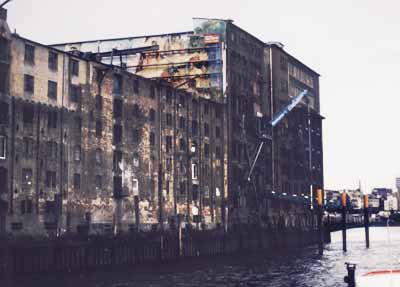
Water side of the fish market warehouse,
top: mural of 1992 with scaffold, 1992
Photo: Hildegund Schuster
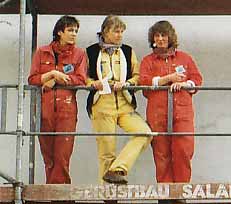
Artists, inauguration 1989
Photo: Britt Stranzen
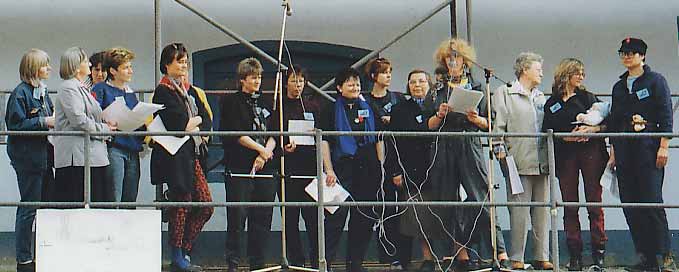
Women from the working party "Women in the Museum of Work" at the inauguration 1989
Photo: Britt Stranzen
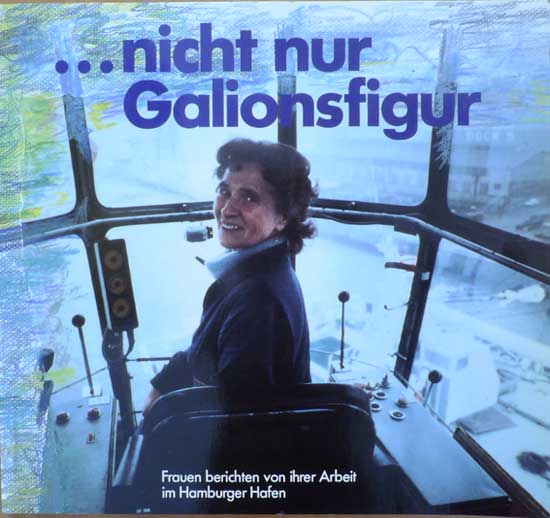
Catalogue book dated 1989
The following were involved in the catalogue book dated 1989 "...Not just figureheads. Women talk about working in the port of Hamburg", published by the Women’s Working Party and the Museum of Work:
authors:
Maria Beimel, Christiane Chodinski, Hilde David, Sarah Deutelmoser, Elisabeth von Dücker, Miryam Freitag, Ulrike Gay, Inge Henker, Sabine von Kessel, Gudrun Kipp, Claudia Krull, Elke Mätschke, Emilija Mitrovic, Gabriele Schärer, Gesa Schneider, Hildegund Schuster, Britt Strantzen, Gisela Utesch.
Artistic and graphical design:
Wiebke Hohrenk, Elena Luksch, Gisela Milse, Johanna Tiedemann.
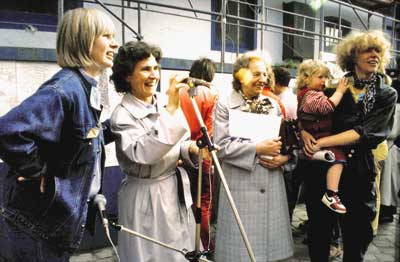
The "First Brush Stroke Celebration on 1 May 1989:
in the middle: crane operator Ida Gellert and welder Elvira Vierke, accompanied by women from the working party: Maria Beimel and Elisabeth von Dücker with daughter Laura.
Photo: Britt Stranzen
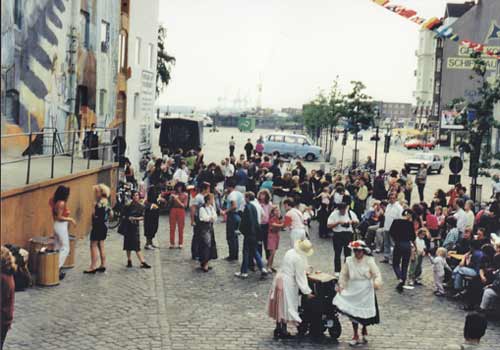
"De-scaffolding" celebration" on 29 July 1989
Photo: Britt Stranzen

